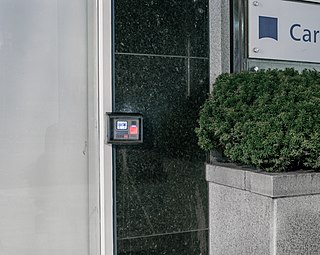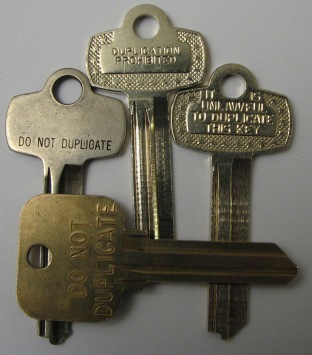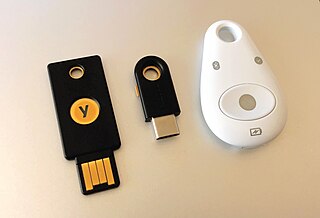Related Research Articles

In physical security and information security, access control (AC) is the selective restriction of access to a place or other resource, while access management describes the process. The act of accessing may mean consuming, entering, or using. Permission to access a resource is called authorization.
Trusted Computing (TC) is a technology developed and promoted by the Trusted Computing Group. The term is taken from the field of trusted systems and has a specialized meaning that is distinct from the field of confidential computing. With Trusted Computing, the computer will consistently behave in expected ways, and those behaviors will be enforced by computer hardware and software. Enforcing this behavior is achieved by loading the hardware with a unique encryption key that is inaccessible to the rest of the system and the owner.

Physical security describes security measures that are designed to deny unauthorized access to facilities, equipment, and resources and to protect personnel and property from damage or harm. Physical security involves the use of multiple layers of interdependent systems that can include CCTV surveillance, security guards, protective barriers, locks, access control, perimeter intrusion detection, deterrent systems, fire protection, and other systems designed to protect persons and property.
Copy protection, also known as content protection, copy prevention and copy restriction, is any measure to enforce copyright by preventing the reproduction of software, films, music, and other media.
Electronic business is any kind of business or commercial activity that includes sharing information across the internet. Commerce constitutes the exchange of products and services between businesses, groups, and individuals; and can be seen as one of the essential activities of any business.

A software protection dongle is an electronic copy protection and content protection device. When connected to a computer or other electronics, they unlock software functionality or decode content. The hardware key is programmed with a product key or other cryptographic protection mechanism and functions via an electrical connector to an external bus of the computer or appliance.
Bank fraud is the use of potentially illegal means to obtain money, assets, or other property owned or held by a financial institution, or to obtain money from depositors by fraudulently posing as a bank or other financial institution. In many instances, bank fraud is a criminal offence.

A lock is a mechanical or electronic fastening device that is released by a physical object, by supplying secret information, by a combination thereof, or it may only be able to be opened from one side, such as a door chain.
Anti-theft systems protect valuables such as vehicles and personal property like wallets, phones, and jewelry. They are also used in retail settings to protect merchandise in the form of security tags and labels. Anti-theft systems include devices such as locks and keys, RFID tags, and GPS locators.

A key blank is a key that has not been cut to a specific bitting. The blank has a specific cross-sectional profile to match the keyway in a corresponding lock cylinder. Key blanks can be stamped with a manufacturer name, end-user logo or with a phrase, the most commonly seen being 'Do not duplicate'. Blanks are typically stocked by locksmiths for duplicating keys. The profile of the key bow, or the large, flat end, is often characteristic of an individual manufacturer.
An information security audit is an audit of the level of information security in an organization. It is an independent review and examination of system records, activities, and related documents. These audits are intended to improve the level of information security, avoid improper information security designs, and optimize the efficiency of the security safeguards and security processes.
Criticism of Windows XP deals with issues with security, performance and the presence of product activation errors that are specific to the Microsoft operating system Windows XP.

Tamperproofing is a methodology used to hinder, deter or detect unauthorised access to a device or circumvention of a security system. Since any device or system can be foiled by a person with sufficient knowledge, equipment, and time, the term "tamperproof" is a misnomer unless some limitations on the tampering party's resources is explicit or assumed.
Physical information security is the intersection or common ground between physical security and information security. It primarily concerns the protection of tangible information-related assets such as computer systems and storage media against physical, real-world threats such as unauthorized physical access, theft, fire and flood. It typically involves physical controls such as protective barriers and locks, uninterruptible power supplies, and shredders. Information security controls in the physical domain complement those in the logical domain, and procedural or administrative controls.

In security, piggybacking, similar to tailgating, refers to when a person tags along with another person who is authorized to gain entry into a restricted area, or pass a certain checkpoint. It can be either electronic or physical. The act may be legal or illegal, authorized or unauthorized, depending on the circumstances. However, the term more often has the connotation of being an illegal or unauthorized act.
Proprietary software is software that grants its creator, publisher, or other rightsholder or rightsholder partner a legal monopoly by modern copyright and intellectual property law to exclude the recipient from freely sharing the software or modifying it, and—in some cases, as is the case with some patent-encumbered and EULA-bound software—from making use of the software on their own, thereby restricting their freedoms.

Multi-factor authentication is an electronic authentication method in which a user is granted access to a website or application only after successfully presenting two or more pieces of evidence to an authentication mechanism. MFA protects personal data—which may include personal identification or financial assets—from being accessed by an unauthorized third party that may have been able to discover, for example, a single password.

Key duplication refers to the process of creating a key based on an existing key. Key cutting is the primary method of key duplication: a flat key is fitted into a vise in a machine, with a blank attached to a parallel vise, and the original key is moved along a guide, while the blank is moved against a blade, which cuts it. After cutting, the new key is deburred: scrubbed with a wire brush, either built into the machine, or in a bench grinder, to remove burrs which, were they not removed, would be dangerously sharp and, further, foul locks.
In computing, defense strategy is a concept and practice used by computer designers, users, and IT personnel to reduce computer security risks.
References
- ↑ "Key Control - SARGENT". Sargentlock.com. Retrieved 2012-08-13.
- ↑ "The Associated Locksmiths of America Technical Standards Policy" (PDF). Aloa.org. Archived from the original (PDF) on 12 May 2008. Retrieved 2013-10-23.
- ↑ "Key Access Control Security, Electronic Key Management Systems, Cabinet Keys". Keytracer.com. Archived from the original on 2012-08-30. Retrieved 2012-08-13.
- ↑ Carter, Ryan (2016). "How Simple Key Control Benefits Retail Store Operations" (PDF). Instakey Security Systems. Retrieved 10 March 2023.